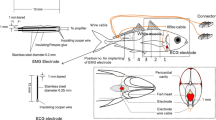Abstract
The effect of temperature on the swimming performance of jack mackerel Trachurus japonicus was examined in a flume tank by measuring the swimming endurance time and heart rate. The lower swimming performance was observed at 10°C (the lowest temperature tested), manifesting as the shortest endurance time and the slowest maximum sustained speed. ECG measurements of the heart rate under free-swimming conditions at zero flow velocity revealed a temperature effect, with 25.3 beats/min observed at 10°C, 38.9 at 15°C, and 67.2 at 22°C. The heart rate also increased with swimming speed to maximum levels of 60, 125, and 208 beats/min, respectively, at these three temperatures. Heart rate recovery times measured after the fish had been swimming at prolonged speed tended to increase with temperature, while a negative correlation resulting in relatively short recovery times was observed after swimming at close to the burst swimming speed at each water temperature.









Similar content being viewed by others
References
Winger DP, He P, Walsh SJ (1999) Swimming endurance of American plaice (Hippoglossoides platessoides) and its role in fish capture. ICES J Mar Sci 56:252–265
He P (1991) Swimming endurance of the Atlantic cod, Gadus morhua L., at low temperatures. Fish Res 12:65–73
Wardle CS (1986) Fish behaviour and fishing gear. In: Pitcher TJ (ed) The behaviour of teleost fishes. Croom Helm, London, pp 463–495
Webb PW (1994) Exercise performance of fish. In: Jones JH (ed) Advances in veterinary science and comparative medicine, vol 38 (B). Academic, Orlando, pp 1–49
Coughlin DJ (2002) Aerobic muscle function during steady swimming in fish. Fish Fish 3:63–78
Clark DT, Butler PJ, Frappell PB (2006) Factors influencing the prediction of metabolic rate in a reptile. Funct Ecol 20:105–113
Farrell AP (1997) Effect of temperature on cardiovascular performance. In: Wood CM, McDonald DG (eds) Global warming: implications for freshwater and marine fish. Cambridge University Press, Cambridge, pp 135–176
Yanase K, Eayrs S, Arimoto T (2007) Influence of water temperature and fish length on the maximum swimming speed of sand flathead, Platycephalus bassensis: implications for trawl selectivity. Fish Res 84:180–188
Reynolds WW, Casterlin EM (1980) The role of temperature in the environmental physiology of fishes. In: Ali AM (ed) Environmental physiology of fishes. Plenum, New York, pp 497–518
Videler JJ, Wardle CS (1991) Fish swimming stride by stride: speed limits and endurance. Rev Fish Biol Fish 1:23–40
He P, Wardle CS (1988) Endurance at intermediate swimming speeds of Atlantic mackerel, Scomber scombrus L., herring, Clupea harengus L., and saithe, pollachius virens L. Fish Biol 33:255–266
Xu G, Arimoto T, Inoue M (1993) Red and white muscle activity of the jack mackerel Trachurus japonicus during swimming. Nippon Suisan Gakkaishi 59:745–751
Webb WP (1975) Hydrodynamics and energetic of fish propulsion (Bulletin 190). Fisheries Research Board of Canada, Ottawa
Breen M, Dyson J, O’Neill GF, Jones E, Haigh M (2004) Swimming endurance of haddock (Melanogrammus aeglefinus L.) at prolonged and sustained swimming speeds, and its role in their capture by towed fishing gears. ICES J Mar Sci 61:1071–1079
An Y, Arimoto T (1994) Avoidance response of jack mackerel to a strobe light barrier. Nippon Suisan Gakkaishi 60:713–718
An Y, Arimoto T (1997) Heart rate change of jack mackerel by strobe light frequency. Nippon Suisan Gakkaishi 63:3–9
Ito H, Akiyama S, Arimoto T (2003) Heart rate change during exercise and recovery for carp Cyprinus carpio. Nippon Suisan Gakkaishi 69:192–196
Nofrizal, Yanase K, Arimoto T (2008) Swimming exercise and recovery for jack mackerel, Trachurus japonicus, monitored by ECG measurements. In: Proc 5th World Fisheries Congr, Yokohama, Japan, 20–24 Oct 2008 (CD-ROM)
Inoue Y, Matsushita Y, Arimoto T (1993) The reaction behaviour of walleye pollock (Theragra chalcogramma) in a deep/low-temperature trawl fishing ground. ICES J Mar Sci 196:77–79
Wardle CS (1980) Effect of temperature on the maximum swimming speed of fishes. In: Ali AM (ed) The environmental physiology of fishes. Plenum, New York, pp 519–531
Woodhead PMJ (1964) Changes in the behaviour of the sole Solea vulgaris, during cold winters, and the relationship between the winter catch and sea temperature. Helgol Wiss Meeresunters 10:328–342
Priede IG (1974) The effect of swimming speed activity and section of the vagus nerves on the heart rate in rainbow trout. Exp Biol 60:305–319
Eckert R, Randal D, Augustine G (1988) Animal physiology: mechanisms and adaptations. WH Freeman and Co., New York
Namba K (1996) ECG measurements of fish. In: Arimoto T, Namba K (eds) Fish behavior and physiology for fish capture technology. Koseisha Koseikaku, Tokyo, pp 74–85 (in Japanese)
Ito H, Akiyama S, Arimoto T (2002) Temperature effect on the function of heart beat for carp Cyprinus carpio. Fish Sci 68(Suppl Ser II):465–466
Chopin SF, Arimoto T (1995) The condition of fish escaping from fishing gear—a review. Fish Res 21:315–327
Author information
Authors and Affiliations
Corresponding author
Rights and permissions
About this article
Cite this article
Nofrizal, Yanase, K. & Arimoto, T. Effect of temperature on the swimming endurance and post-exercise recovery of jack mackerel Trachurus japonicus as determined by ECG monitoring. Fish Sci 75, 1369–1375 (2009). https://doi.org/10.1007/s12562-009-0164-3
Received:
Accepted:
Published:
Issue Date:
DOI: https://doi.org/10.1007/s12562-009-0164-3




